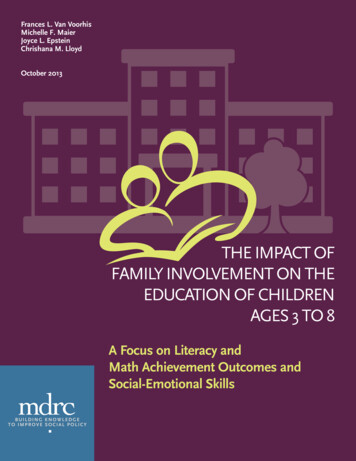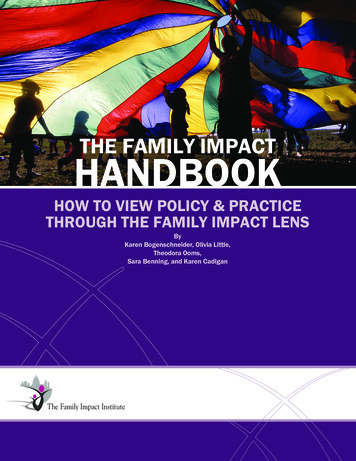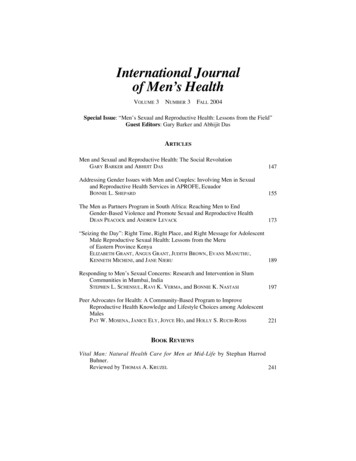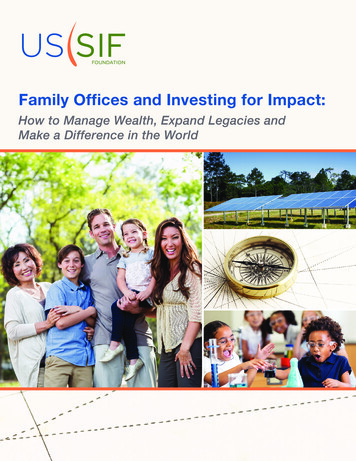
Transcription
Frances L. Van VoorhisMichelle F. MaierJoyce L. EpsteinChrishana M. LloydOctober 2013THE IMPACT OFFAMILY INVOLVEMENT ON THEEDUCATION OF CHILDRENAGES 3 TO 8A Focus on Literacy andMath Achievement Outcomes andSocial-Emotional Skills
The Impact of Family Involvementon the Education of Children Ages 3 to 8A Focus on Literacy and Math Achievement Outcomesand Social-Emotional SkillsFrances L. Van Voorhis(Center on School, Family, and Community Partnershipsat Johns Hopkins University)Michelle F. Maier(MDRC)Joyce L. Epstein(Center on School, Family, and Community Partnershipsat Johns Hopkins University)Chrishana M. Lloyd(MDRC)withTherese Leung(MDRC)October 2013
This literature review is being funded through a grant from the Heising-Simons Foundationunder Grant Number 2013-30.Dissemination of MDRC publications is supported by the following funders that help financeMDRC’s public policy outreach and expanding efforts to communicate the results and implications of our work to policymakers, practitioners, and others: The Annie E. Casey Foundation, TheGeorge Gund Foundation, Sandler Foundation, and The Starr Foundation.In addition, earnings from the MDRC Endowment help sustain our dissemination efforts. Contributors to the MDRC Endowment include Alcoa Foundation, The Ambrose Monell Foundation,Anheuser-Busch Foundation, Bristol-Myers Squibb Foundation, Charles Stewart Mott Foundation, Ford Foundation, The George Gund Foundation, The Grable Foundation, The Lizabeth andFrank Newman Charitable Foundation, The New York Times Company Foundation, Jan Nicholson, Paul H. O’Neill Charitable Foundation, John S. Reed, Sandler Foundation, and The StupskiFamily Fund, as well as other individual contributors.The findings and conclusions in this report do not necessarily represent the official positions orpolicies of the funders.For information about MDRC and copies of our publications, see our Web site: www.mdrc.org.Copyright 2013 by MDRC . All rights reserved.
OverviewThis report summarizes research conducted primarily over the past 10 years on how families’involvement in children’s learning and development through activities at home and at schoolaffects the literacy, mathematics, and social-emotional skills of children ages 3 to 8. A total of95 studies of family involvement are reviewed. These include both descriptive, noninterventionstudies of the actions families take at home and at school and intervention studies of practicesthat guide families to conduct activities that strengthen young children’s literacy and mathlearning. The family involvement research studies are divided into four categories: Learning activities at home, including those that parents engage in to promote their child’sliteracy and/or math skills outside school Family involvement at school, including the actions and interactions that families havewhile in the school building School outreach to engage families, including the strategies that schools and teachers useto engage families and make them feel welcome Supportive parenting activities, including the nature and quality of the parent-child rela-tionship and home environment, rule-setting, and caring behaviorsKey Findings Family involvement is important for young children’s literacy and math skills. The ma-jority of studies, including some randomized control trials (RCTs), demonstrate this positivelink. A few studies show positive relations with social-emotional skills. The weakest association was between family involvement at school and children’s outcomes. Parents from diverse backgrounds, when given direction, can become more engagedwith their children. And when parents are more engaged, children tend to do better. This review also provides recommendations for additional lines of inquiry and implica-tions to guide next steps in both research and practice. While there is still more to learnabout how to connect with and support caretakers’ efforts to promote children’s learning,what we already know from extant research can help guide this process.More children attend preschool and all-day kindergarten than ever before, and educators arebeing urged by federal, state, and local institutions to use research-based or evidence-based approaches to improve their work with families and families’ involvement with their children andthe school. This review strengthens the belief that interventions to boost family involvementmay be a critical piece when trying to support children’s early learning.iii
ContentsOverviewList of ExhibitsPrefaceAcknowledgmentsExecutive SummaryiiiviiixxiES-1Chapter1Introduction12Family Involvement in Reading and Literacy Activities and Results forChildren’s Literacy Achievement and Social-Emotional Skills73Family Involvement in Math Activities and Results for Children’s MathAchievement and Social-Emotional Skills514Summary, Reflections, and Recommendations75AppendixAStudies of Family Involvement in Literacy Activities and Math Activitiesand Social-Emotional OutcomesBExamples from the Field: Family Involvement Activities with YoungChildrenGlossaryCReferencesGeneral ReferencesReferences for Chapter 2: Reading and Literacy ActivitiesReferences for Chapter 3: Math Activitiesv87163181187191198
List of ExhibitsTable1.1Description of Journal Articles for Literacy and Math Reviews6A.1Studies of Family Involvement in Literacy Activities and Literacy and SocialEmotional OutcomesA.2Studies of Family Involvement in Math Activities and Math and Social-EmotionalOutcomes127B.1Examples from the Field from Preschool to Elementary School: Family InvolvementActivities of Reading with Young Children169B.2Examples from the Field from Preschool to Elementary School: Family InvolvementActivities of Math with Young Children173B.3Examples from the Field from Preschool: Transition Activities with Young Childrenand Families17789Box2.1Feature Study: Family Involvement in Reading Activities at Home132.2Feature Study: Effects of Parent Intervention on Play and Learning Strategies(PALS) on Achievement and Social-Emotional Skills162.3Feature Studies: Parent-Child Conversations at Home182.4Feature Study: Multiple Measures of Family Involvement in Learning Activities atHome Versus Other Types of Family Involvement212.5Feature Study: Effects of Family Involvement at Home on Learning and Behavior222.6Feature Study: Effects of Family Involvement at School Over Time282.7Feature Study: Composite Measure of Parental Involvement and Children’sAchievement and Social-Emotional Skills392.8Feature Study: Intervention on Supportive Parenting and Achievement Outcomes432.9Feature Study: Change in Supportive Parenting and Results for Children’sAchievement and Social-Economical Skills453.1Feature Study: Intervention to Increase Parent Involvement in Math Activities atHome553.2Feature Study: Intervention to Increase Parent Involvement in General LearningActivities at Home58vii
Box3.3Feature Study: Nonintervention Exploration of Composite Measures of ParentalInvolvement and Children’s Learning and Behavior604.1Reading and Literary-Related Activities Engaged in by Children and Families844.2Math-Related Activities Engaged in by Children and Families85viii
PrefaceIn recent years, large investments have been made in the early childhood field with the goal ofpositively affecting young children’s outcomes through two areas of inquiry: (1) parenting andhome visiting and (2) early childhood care and education. This commitment is underscored byPresident Obama’s Early Learning Initiative, with its focus on a continuum of high-quality earlylearning for every child in America from birth to age 5 and its aim of “leveling the playingfield” for children from lower-income families. The family involvement research that issummarized in this report is firmly situated at the nexus of these two important areas of work,connecting what happens in the home with what happens in the school — while keeping thechild and positive child development as the primary focus. Given this context and the increasedexpectation that education systems use research-based or evidence-based approaches in theirwork with families, the connection between home and school — and how best to support it —is likely a critical piece of the puzzle of how to comprehensively promote children’s earlylearning.This report on almost 100 family involvement research studies focusing on the literacy,math, and socio-emotional skills of children ages 3 to 8 is a timely contribution to the field. Itpresents the most rigorous empirical work that has been conducted, primarily over the past 10years. The review finds that parents from diverse backgrounds, when given direction, canincrease their involvement with their children’s learning at home and at school and that, whenparents are more involved and more engaged, children tend to do better academically andsocially. More importantly, this review makes explicit recommendations for further lines ofinquiry and offers several implications to guide next steps in both research and practice. Whilethere is still much more to learn about how to connect with and support families’ efforts topromote children’s learning across the home and school contexts most effectively, this report isa much-needed first step.Gordon L. BerlinPresidentix
AcknowledgmentsThis literature review was conducted with the Heising-Simons Foundation. We extend our sincere thanks to Holly Kreider, Program Officer, and Deanna Gomby, Executive Director, fromHeising-Simons for their ongoing support and guidance.We want to thank the authors of, and the families and children who participated in, thenumerous studies that we drew on for this report. We also acknowledge a number of colleaguesfrom MDRC who were involved in this literature review. Virginia Knox, Families and ChildrenPolicy Area Director and Senior Adviser for this work, provided valuable feedback on initialdrafts of this report. Jennifer Garcia and Jennifer Somers assisted in the initial literature reviewand in producing detailed appendix tables.We extend much thanks to M. Elena Lopez, Associate Director at Harvard Family Research Project, for her incredibly detailed and thorough review of this report. Her thoughts andguidance pushed our thinking in multiple ways, leading to additional emphasis on how the findings can be applied to practitioners and the field at large. We also thank Laurie Miller Brotman,Prevention Science Professor of Child and Adolescent Psychiatry and Psychiatry and the Director of the Institute for Prevention Science at the Child Study Center at New York University, forlending her expertise and providing two rounds of thoughtful comments and review.Robert Weber edited the report, and Stephanie Cowell prepared it for publication.The Authorsxi
Executive SummaryChildren benefit when parents and family members get involved in their learning and development. This conclusion is supported by decades of research that suggests that family engagement is positively linked to children’s outcomes in preschool, kindergarten, and earlyelementary grades.Yet it has been unclear how families affect their children’s learning at home and inschool and how the establishment of a partnership between families and schools can lead topositive outcomes for children. We still do not know what aspects of family involvement areimportant for children’s learning. For example, is it better for parents to conduct early learningactivities at home or at school? And what types of early learning activities can parents do withtheir children that are critical to learning and development? And in what ways can schools andteachers guide and encourage parents to do these things with their children?To help answer these questions, this report summarizes the research conducted overthe past 10 years on the effects of family involvement activities at home and at school onliteracy, mathematics, and social-emotional skills for children ages 3 to 8. In addition, itprovides new information on the impact of family involvement on these skills specifically forpreschool children, and it pays special attention to the practices necessary to help prepareparents and children for the transition from preschool to kindergarten. Finally, this reportidentifies the gaps in knowledge that future research should address, and it discusses how touse research findings to inform and improve practice.Several terms in this report are used interchangeably both in the field and in research.For instance, “involvement” and “engagement” are both used but convey the same meaning.And while we recognize that many individuals in a family may play important roles in a child’slearning at home and at school, most studies examine parents or caregivers; therefore, we usethe words “family” and “parent” interchangeably. Finally, in this report, “children” and “students” are used synonymously.Overview of the ResearchThe studies reviewed in this report represent the most rigorous work conducted over the pastdecade on the nature and effects of family involvement on young children’s literacy, math, andsocial-emotional skills. A total of 95 studies of family involvement practices as they affectyoung children’s literacy and math learning and social-emotional skills are reviewed: 52 studieson literacy and 43 studies on mathematics. These include both descriptive, nonintervention(nonexperimental) studies of the actions that families take at home and at school and intervention (both experimental and quasi-experimental) studies of programs that help structure fami-ES-1
lies’ engagement in activities that could strengthen or increase young children’s literacy andmath learning.Unfortunately, only a limited number of intervention studies have used rigorous, experimental designs. Chapter 2, on family involvement in reading and literacy activities, reports on 9individual intervention studies and more than 120 interventions included in 8 meta-analyses.Chapter 3, on family involvement in math activities, reports on 7 intervention studies and morethan 20 intervention studies included in 2 meta-analyses. These studies embrace varyingstandards of evidence. Although some use randomized control trials (RCTs), the vast majorityof individual intervention studies do not provide enough information about analytic or methodological weaknesses, such as not using an intent-to-treat analysis or not reporting on interventionimplementation or study design flaws (that might result, for example, in differential attrition).Nevertheless, these studies do provide useful guidance when determining the future directionsof family involvement research. (Appendix Tables A.1 and A.2 provide details about all thereviewed studies.)The family involvement research on both literacy and math were divided into four categories to reflect how parents support their children’s learning in a variety of ways and indifferent settings (Epstein, 2011; Epstein et al., 2009): 11. Learning activities at home. These studies focused specifically on the homeactivities that parents engage in to promote literacy, math, or both (or moregeneral academic activities). These activities may also occur wherever children learn with their parents, such as in libraries, museums, and family resource centers.2. Family involvement at school. These studies examined the actions and interactions that parents and other family members have while at the schoolbuilding (for example, during an open house or parent-teacher conference,while participating in the classroom, or volunteering).3. School outreach to engage families. These studies examined the strategiesand practices that schools and teachers use to engage families and make themfeel welcome. Special attention was paid to the processes that schools used toprepare preschool children and families for the move to kindergarten.1Epstein, J. L. (2011). School, family, and community partnerships: Preparing educators and improvingschools (2nd ed.). Westview Press.Epstein, J. L., Sanders, M. G., and Sheldon, S., Simon, B. S., Salinas, K. C., Jansorn, N. R. (Rodriquez), VanVoorhis, F. L., Martin, C. S., Thomas, B. G., Greenfield, M. D., Hutchins, D. J., and Williams, K. J. (2009).School, family, and community partnerships: Your handbook for action (3rd ed.). Thousand Oaks, CA: CorwinPress.ES-2
4. Supportive parenting activities. These studies examined activities that parents conduct to support their children’s development and well-being, including the nature and quality of the parent-child relationship; parenting activities, such as setting rules at home; and caring behaviors that characterize thehome environment in general. This is in contrast to parents’ conducting specific literacy or math activities at home with their children.Research ResultsAcross the studies reviewed, we were able to draw two main conclusions. First, the majority ofstudies — including some RCTs — demonstrate that family involvement is positively linked tochildren’s literacy and math skills in preschool, kindergarten, and the early elementary grades.A few studies also show increases in children’s social-emotional skills. The weakest link wasbetween family involvement at school and children’s outcomes.Second, the most rigorous studies that use random assignment show that parents fromdiverse backgrounds, when given direction, can become more engaged with their children onliteracy and math activities — and that their children can increase their reading and math skills,on average, more so than children whose parents are operating without support or direction.These studies demonstrate that family-focused intervention has small-to-moderate effects on children’s learning. Note, however, that the study designs varied and that only fivestudies demonstrating positive effects also employed the gold standard from which to drawcausal conclusions: random assignment. Eight other studies had comparison groups but notrandom assignment and also demonstrated positive results, providing additional, yet cautious,confidence in the conclusions. Importantly, these conclusions indicate that there is much moreto be learned in the field of family involvement and early childhood, and they point to the needfor more rigorous work in this area.Implications for Improving PracticeAlthough more research is needed to fully understand family involvement, its impact on youngchildren’s early reading and math skills and readiness for school, and the implications forpractice, a number of lessons are emerging that can immediately inform the field.The studies in this review indicate that, with guidance, many parents — across all socioeconomic, educational, and racial or ethnic backgrounds — are interested in and able to conductlearning activities at home with their young children. Parents and their children engaged in ahost of activities (including shared book reading, dialogic reading, home tutoring, and familyconversations), and these activities were related to positive results for children’s vocabulary,listening comprehension, rates of word reading, story comprehension, and other reading skills.ES-3
Similarly, when parents and their children are engaged in various math-related activities–– such as counting, playing with shapes and puzzles, money math, and addition and subtraction –– such activities are associated with positive results on children’s math knowledge andskills across a variety of assessments.The interventions that were both sustained and targeted were the most effective. Interventions that lasted for longer periods of time and that were clearly defined in relation tooutcomes that logically flow from a theory of change were associated with greater gains inachievement.Many preschools and elementary schools are implementing involvement activities withfamilies to strengthen children’s reading and math skills and to improve the transition processfrom preschool to kindergarten. Appendix B summarizes a few of the hundreds of activities thathave been implemented by practitioners in schools in the National Network of PartnershipSchools (NNPS) at Johns Hopkins University and that are reported in annual books of Promising Partnership Practices.But the connection between research findings and their practical implications can bestrengthened even further to promote greater and more equitable parental involvement. Someparents conduct activities that support and increase their young children’s learning without anyencouragement, but the studies in this review demonstrate that all parents can be more involved in literacy and math activities. Parents may not be aware of which activities to conductand how to conduct them to support their young children’s literacy and math skills and schoolbehaviors, so schools and teachers need to take an active role in engaging all families. Preschools and elementary schools, community groups, and leaders must be intentional aboutincluding families as an integral part of their school or program philosophy. This outreach isimportant for all parents — and especially so for those whose children are most at risk ofhaving learning problems.Implications for Future ResearchRegardless of the type of family involvement and the methodological design of these studies,the results reveal critical insights that can direct future research: More studies are needed that specifically identify which family involvement practices and which school outreach strategies are most effectivefor all students and families, specific subgroups of students and families,and at varying grade levels. In addition, studies should examine fathers’(and mothers’) roles in family involvement, potential moderators to ascertainwhom or under what conditions interventions are effective, and the mechanisms by which family involvement works to influence children’s learning.ES-4
Finally, more research –– particularly, experimental work –– needs to reporton the fidelity of implementation of a program or intervention model. More well-designed, rigorous experimental studies are needed that examine immediate and cumulative effects of family involvement interventions. The literature review found few experimental studies compared withnonexperimental studies, and, even within the experimental ones, there werevarying levels of evidence with (unreported) analytic or methodologicalweaknesses. In addition, most studies paid minimal attention to measuringfidelity of implementation to the intended model of family involvement. Ideally, future experimental studies would use random assignment and an intentto-treat analysis; would report on fidelity of implementation; and would include theoretically linked child outcome measures, which would providestronger evidence of a positive impact of specific family involvement activities on particular child outcomes. Finally, studies should examine both immediate and cumulative effects of interventions across age and grade levels. Studies that use longitudinal data can show how the trajectory of familyinvolvement changes as children develop and how that may relate tospecific outcomes. Studies based on cross-sectional data can demonstrate therelationship between family involvement and children’s outcomes at onepoint in time, but longitudinal studies can measure change in family involvement and the dynamics between family involvement and outcomes overtime. The studies reviewed in this report show not only that family involvement does matter at one point in time but also that positive change in familyinvolvement is associated with better outcomes. More research should examine the link between family involvement andboth math and social-emotional skills. Compared with literacy studies,fewer studies examined the effects of family involvement on math, and evenfewer focused on social-emotional skills. Often, measures of children’s social-emotional skills were casually added onto studies without a strong theoretical rationale, which dilutes the importance of these kinds of critical skillsthat help children understand and control their feelings and get along withpeers and teachers. Future studies should examine how to expand and scale up the researchtested programs and practices of family involvement with children onreading and math activities. The ultimate goal is to understand how to scaleup good practices that will help a significantly large number of parents become involved in productive, feasible, and fun ways to help their children’sES-5
learning and development. We need more studies that examine the processesnecessary to scale up effective interventions, moving the conduct of treatment and control group practices from researchers’ tight controls to realworld tests of teachers’ practices. Studies should align specific family involvement activities — as well asmeasures of them — with explicit child outcomes. Many studies illustratethat highly specific measures of family involvement are more likely linked topositive child outcomes, in contrast to studies that use composite measures offamily involvement, which tend to confound the separable types of involvement (Epstein, 2011). For example, studies that examine whether parents areengaged in guided reading and math activities help to produce specific resultsfor students in reading and math. Conversely, composite outcome measures(such as combined reading and math test scores) tend to obscure an understanding of whether and which family involvement actions contribute to particular learning outcomes. Studies should pay more attention to the transition from preschool to kindergarten. Several nonintervention studies indicate that specific, well-plannedstrategies and welcoming practices not only help children and their parents adjust to a new school but also are associated with better child outcomes.ConclusionMore children attend preschool and all-day kindergarten than ever before, and the strong pushfor universal preschool education by various policymakers suggests that the number willcontinue to increase.Educators are being urged by federal, state, and local institutions to use research-basedor evidence-based approaches to improve their practices around family involvement so that theycan produce positive results for all children. This review strengthens the position that interventions to bolster family involvement are likely to be part of the solution when the goal is toimprove children’s early learning. It offers several important recommendations — for bothresearchers and educators — that guide the next steps in an important policy agenda of promoting children’s development and learning.ES-6
Chapter 1IntroductionIt is well established that parents matter greatly for their children’s development and successboth in and out of school. Yet there are no manuals or sure strategies for raising happy, caring,confident, and successful children. Parents do their best with the information that they have orreceive to teach their infants to walk and talk, help toddlers learn and play, and help youngchildren get ready to succeed in school. Teachers, too, work diligently to foster their students’academic achievement and social and emotional development. As they work with good intentions to guide their children, parents and teachers experience many bumps in the road.Research has been accumulating for decades on the importance of high-quality preschool education to prepare children for their journey through school (Reynolds, 2000; Reynolds,Temple, Robertson, and Mann, 2001). At the same time, for more than 30 years (Kagan, 1984;Epstein, 1995; Becker and Epstein, 1982), research on family and community involvement hasshown that children are more successful in school when their parents and teachers communicatewell and work together effectively (Epstein, 2011; Henderson, Mapp, Johnson, and Davies,2007). Countless studies indicate that, at any grade level, including prekindergarten, challengingcurriculum, important learning goals, effective assessments, responsive feedback for students,and parental involvement are important for increasing student achievement, attendance, behavior, and other important school outcomes (Bryk, Sebring, Allensworth, Luppescu, and Easton,2011; Marzano, 2003; Sheldon, 2003). Although the relevant studies vary in size, duration, datacollected, and methods of analyses, the body of literature points in one direction: Children benefitwhen parents and teachers work together as partners in education.Despite the generally positive findings of hundreds of studies, the application of research findings in homes and schools is rare, often occurring with families who are alreadyengaged and sometimes without attention to what has been learned to be particularly effective inresearch. Popular media have played a role in helping to educate parents on ways to supportchildren’s development, making it easier for parents to understand, internalize, and applygeneral research findings (such as Capretto, 2012; Feiler, 2012; Larsen and Rodgers, n.d.). Forexample, more parents now than in the past read with their young children and conduct otherevidence-based early reading and math activities with infants and toddlers. The percentage ofprekindergarten children (ages 3 to 5) who were read to frequently by a family member (that is,three times or more in the week preceding the survey) increased from 78 percent in 1993 to 86percent in 2005 (U.S. Department of Education, 2006). Over this time period, parents or otherfamily members also were more likely to frequently tell their children stories (from 43 percentin 1993 to 54 percent in 2005); work with their children on letters, words, and numbers (from58 percent to 77 percent); and teach their children songs or music (from 41 percent to 541
percent). Although family poverty level affected the number of students read to by a parent (90percent of children in families over the poverty line, compared with 78 percent of children infamilies below the poverty line), there were no sign
Family involvement is important for young children's literacy and math skills. The ma-jority of studies, including some randomized control trials (RCTs), demonstrate this positive link. A few studies show positive relations with social-emotional skills. The weakest asso-ciation was between family involvement at school and chi ldren's .










